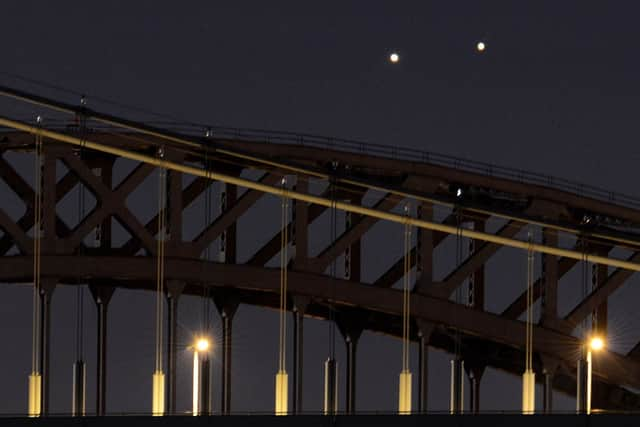Venus Jupiter conjunction: how to see 2022 planet alignment, meaning - how to view Saturn and Jupiter’s moons
and live on Freeview channel 276
Two of the Solar System’s brightest planets are set to “conjoin” in the night sky tonight, with the celestial bodies appearing to almost graze one another.
Of course, Jupiter and Venus will actually be separated by millions of miles of space, but from our perspective on Earth, they will look as if they are close to touching.
Advertisement
Hide AdAdvertisement
Hide AdIt will be the closest the two planets have appeared to be since a similar event - known as a “conjunction” - in 2016, but just how can you see the astronomical spectacle for yourself?
Here is everything you need to know about it.
How close will the planets appear?
The conjunction brings Venus and Jupiter to within half a degree of each other, which is equivalent to the width of the moon as seen from Earth.
In actuality, the planets of the solar system are relatively far apart; Venus will be 90.3 million miles away from Earth, while Jupiter will be 530 million miles away.
Tonight’s conjunction marks the ‘closest’ Venus and Jupiter have been to one another since August 2016, and it will be another year until the next such event, when the two planet’s brush past each other on 1 March 2023.
Advertisement
Hide AdAdvertisement
Hide AdBut while they’ll come close again in 12 months’ time, it’ll be a lot longer until they appear as close - 2039 is the expected date of the next closest conjunction.


When is the best time to see the conjunction?
Since Venus and Jupiter are two of the Solar System’s brightest planetary bodies, in a clear sky, they should both be easily visible with the naked eye or binoculars.
The planets will appear at their closest on the evening of Saturday 30 April at 8pm BST, although they won’t be visible from the northern hemisphere at that time.
The best time to see the planets is early in the morning, just before sunrise - before they are outshone by the Sun's glare - when they will appear low in the sky, near to the horizon.
Advertisement
Hide AdAdvertisement
Hide AdBut the planets will appear close to each other for several days around 30 April.
What do I need to see it?
The view of the horizon may be obstructed by hills and buildings, so you’ll want to find a high vantage point and search for two dazzlingly bright lights that are extremely close together.
The early hours of 30 April were arguably the best time to see the conjunction, though they will still appear close in the sky on the morning of Sunday 1 May.
The brightness of the planets will vary. Venus is brighter than Jupiter, which is significantly less bright, roughly one-sixth as luminous.
Advertisement
Hide AdAdvertisement
Hide AdYou can also utilise various smartphone apps to assist you in navigating the sky.
If you have a telescope, you might be able to see some structure in Jupiter's atmosphere or some of its larger moons, as well as a glimpse of Mars and Saturn making a four-planet line.
In the coming days the two planets start to get further and further apart, but you should still be able to easily spot them in the morning skies.
Comment Guidelines
National World encourages reader discussion on our stories. User feedback, insights and back-and-forth exchanges add a rich layer of context to reporting. Please review our Community Guidelines before commenting.
